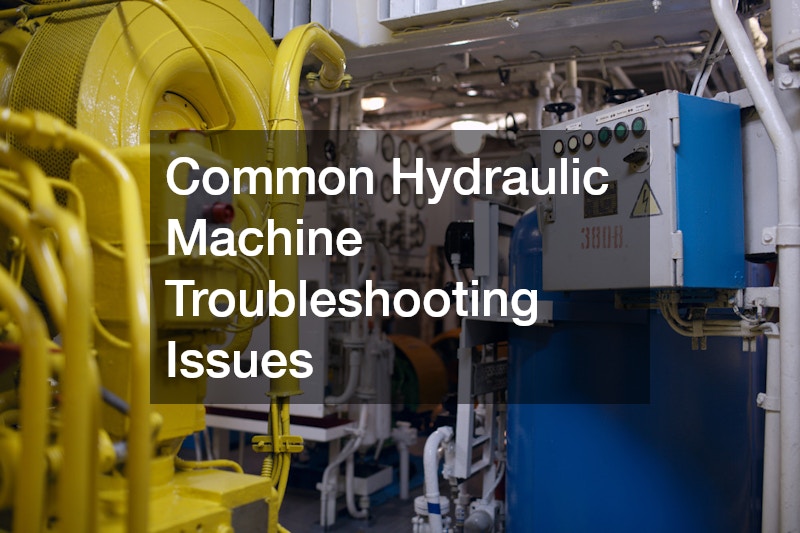
Hydraulic machines are integral to various industries due to their power and efficiency, yet they often encounter problems that can hinder their performance. Understanding these challenges, such as pump failures, system leaks, and overheating, is vital for maintaining operations. This article delves into common hydraulic machine troubleshooting, their root issue causes, and practical solutions to enhance equipment performance and prevent downtime.
Hydraulic pump failures can be perplexing, often resulting from a lack of maintenance or the use of substandard fluids. Such failures typically present themselves through symptoms like excessive noise or reduced efficiency and pressures.
Video Source
Diagnosing these issues requires careful analysis of the system's operational parameters, fluid quality, and mechanical alignment.
Each symptom points to a potential root cause that, if accurately identified, can spare operators from costly repairs. Routine checks for temperature and pressure fluctuations are essential for early diagnosis. With accurate identification, operators can avert further damage by addressing these issues promptly through appropriate mechanical adjustments or fluid replacements.
Moreover, understanding the influence of environmental factors, such as temperature and contamination, assists in diagnosing hydraulic pump issues. Regular monitoring and maintaining ideal conditions for the pumps can prevent premature failures. Emphasizing the importance of choosing the right hydraulic fluid cannot be underestimated in this regard.
Hydraulic leaks are a ubiquitous issue, often stemming from worn seals, damaged hoses, or loose fittings. Even minor leaks can lead to significant performance declines and safety concerns. Identifying the leak's origin is crucial, as is ensuring all components are secure and free from damage.
Effective sealing requires knowing whether the fault lies within the material deterioration or an improper connection. Replacing faulty seals, tightening connections, or addressing wear and tear promptly can curtail leakages effectively. Periodic inspections help in recognizing the signs of impending leaks before they manifest fully.
Seal integrity is essential, and frequent maintenance ensures that system pressure is maintained without the risk of fluid escaping. Preventative measures such as protective coverings for hoses can guard against abrasion-related leaks. Utilizing high-quality components designed for specific operational conditions is key to preventing future leaks.
Overheating in hydraulic systems is a troublesome issue often caused by excessive pressure, poor-quality fluids, or environmental factors. It can seriously undermine system efficiency and longevity. Addressing these factors involves both immediate and long-term strategies.
Quick mitigation can include reducing peak system loads and ensuring that coolants are topped off and effective. Regular maintenance to check filters and fluids prevents excessive heat build-up over time. Operators need a keen understanding of how ambient temperatures and workload demands affect heat generation within the system.
Long-term solutions may involve choosing alternative fluids or upgrading cooling systems to match performance requirements. Where feasible, investing in more advanced thermostats and monitoring systems can prevent overheating from compromising operations. Implementing these changes can substantially extend equipment life and maintain efficiency.
Air and water contamination in hydraulic systems can disrupt operations by causing erratic motion, noise, and potential system failures. Common causes include faulty reservoir breathing systems or poor fluid handling practices. Contaminants lead to increased wear and premature system degradation.
Identifying contamination sources and eliminating them is critical for maintaining system integrity. Using desiccant breathers and ensuring thorough filtering of fluids protects against these external contaminants. Operators should also practice cautious fluid replacement procedures to minimize exposure.
Proactive contamination prevention measures include regular fluid analysis and using high-grade filter elements designed to capture fine particulates. Additionally, sealing reservoirs effectively and maintaining equipment cleanliness can reduce the risk of contamination entering the system, thereby preserving equipment's performance and reliability.
Noise from hydraulic systems is a common indicator of underlying issues like cavitation or worn components. Such noises not only disrupt operations but also signal inefficiencies or potential failures. Addressing its causes promptly is crucial for operational smoothness.
Sourcing the noise often involves checking for trapped air within the system or inspecting for loose or misaligned parts. Calibration of relief valves and ensuring proper fluid viscosity are steps to prevent noise recurrence. Regular monitoring of components prone to wear can also preemptively tackle noise at its source.
Understanding common hydraulic machine issues and implementing effective troubleshooting practices are key to sustaining machinery performance. Proactive maintenance, accurate diagnostics, and strategic interventions mitigate failures, leaks, overheating, contamination, and noise issues. By emphasizing routine checks and education on fluid quality and system calibration, operators can ensure the longevity and reliability of hydraulic equipment.
.